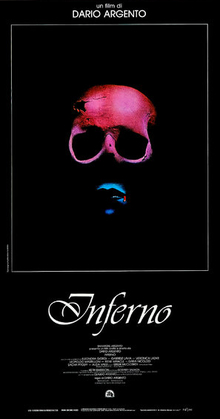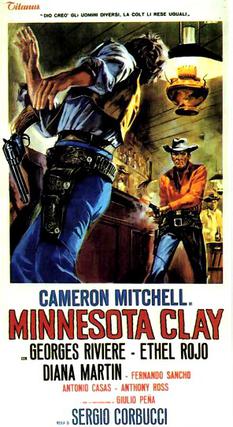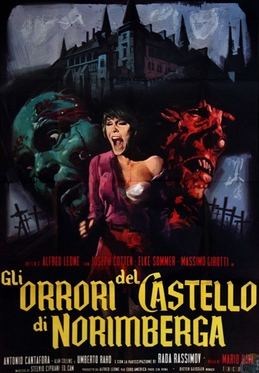
Black Sabbath is a 1963 horror anthology film directed by Mario Bava. The film consists of three separate tales that are introduced by Boris Karloff. The order in which the stories are presented varies among the different versions in which the film has been released. In the original, Italian print, the first story, titled "The Telephone", involves Rosy who continually receives threatening telephone calls from an unseen stalker. The second is "The Wurdulak", where a man named Gorca (Karloff) returns to his family after claiming to have slain a Wurdulak, an undead creature who attacks those that it had once loved. The third story, "The Drop of Water", is centered on Helen Corey, a nurse who steals a ring from a corpse that is being prepared for burial and finds herself haunted by the ring's original owner after arriving home.
Timothy Ray Lucas is an American film critic, biographer, novelist, screenwriter and blogger, best known for publishing and editing the video review magazine Video Watchdog.
Black Angel is a 1946 American film noir starring Dan Duryea, June Vincent and Peter Lorre. Directed by Roy William Neill, it was his final feature film. Produced by Universal Pictures, it is set in Los Angeles and broadly adapted from Cornell Woolrich's 1943 novel The Black Angel.

Lamberto Bava is an Italian film director. Born in Rome, Bava began working as an assistant director for his director father Mario Bava. Lamberto co-directed the 1979 television film La Venere d'Ille with his father and in 1980 directed his first solo feature film Macabre.

Blood and Black Lace is a 1964 giallo film directed by Mario Bava and starring Eva Bartok and Cameron Mitchell. The story concerns the brutal murders of a Roman fashion house's models, committed by a masked killer in a desperate attempt to obtain a scandal-revealing diary.

The Girl Who Knew Too Much is a 1963 Italian giallo film directed by Mario Bava, starring John Saxon as Dr. Marcello Bassi and Letícia Román as Nora Davis. The plot revolves around a young American woman named Nora, who travels to Rome and witnesses a murder. The police and Dr. Bassi do not believe her, since a corpse has not been found. Several more killings follow, tied to a decade-long string of murder victims chosen in alphabetical order.

Danger: Diabolik is a 1968 action and crime film directed and co-written by Mario Bava, based on the Italian comic series Diabolik by Angela and Luciana Giussani. The film is about a criminal named Diabolik, who plans large-scale heists for his girlfriend Eva Kant. Diabolik is pursued by Inspector Ginko, who blackmails the gangster Ralph Valmont into catching Diabolik for him.

Inferno is a 1980 Italian supernatural horror film written and directed by Dario Argento, and starring Irene Miracle, Leigh McCloskey, Eleonora Giorgi, Daria Nicolodi and Alida Valli. The plot follows a young man's investigation into the disappearance of his sister, who had been living in a New York City apartment building that also served as a home for a powerful, centuries-old witch. The cinematography was by Romano Albani, and Keith Emerson composed the film's musical score.

The Hunchback of Notre Dame II is a 2002 American animated musical film directed by Bradley Raymond. It is a direct-to-video sequel to Disney's 1996 animated feature film The Hunchback of Notre Dame. The film was produced by the Japanese office of Walt Disney Animation and Walt Disney Television Animation, while it was distributed by Walt Disney Studios Home Entertainment. Much of the actors from the original film reprise their roles, with the addition of new characters played by Jennifer Love Hewitt, Michael McKean and Haley Joel Osment. Critical reception was mostly negative.

Minnesota Clay is a 1964 Spaghetti Western directed by Sergio Corbucci.

Demons 2 is a 1986 Italian horror film directed by Lamberto Bava and produced by Dario Argento. It is a sequel to Bava's 1985 film Demons and stars David Knight, Nancy Brilli, Coralina Cataldi Tassoni, as well as Argento's youngest daughter, Asia Argento, in her debut film performance at age 10. In the film, demons invade the real world through a television broadcast, turning the residents of an apartment building into bloodthirsty monsters.
"The Doorman" is the 104th episode of the NBC sitcom Seinfeld. This is the 18th episode for the sixth season. It aired on February 23, 1995. In this episode, Jerry and Elaine contend with a creepy doorman, George fears he is developing male breasts, and Kramer and Frank Costanza try to go into business with a bra for men.

The Day the Sky Exploded, released in the United Kingdom as Death Comes From Outer Space, is a 1958 French/Italian international co-production science fiction film. It is known as the first Italian science fiction film, predating even the science fiction films of Antonio Margheriti.

Five Dolls for an August Moon is a 1970 Italian giallo film directed by Mario Bava. It concerns a group of people who have gathered on a remote island for fun and relaxation. One of the guests is a chemist who has created a revolutionary new chemical process, and several of the attending industrialists are eager to buy it from him. Business problems become moot when someone begins killing off the attendees one by one.

Shock is a 1977 Italian supernatural horror film directed by Mario Bava and starring Daria Nicolodi, John Steiner, and David Colin, Jr. Its plot focuses on a woman who moves into the home she shared with her deceased former husband, where she finds herself tormented by supernatural occurrences. It was Bava's last theatrical feature before he died of a heart attack in 1980.

Hatchet for the Honeymoon is a 1970 giallo film directed by Mario Bava and starring Stephen Forsyth, Dagmar Lassander, Laura Betti, and Femi Benussi. The story follows John Harrington, a hatchet-wielding madman who murders young brides in an effort to recall a childhood trauma.

Éponine Thénardier, also referred to as "Ponine", the "Jondrette girl" and the "young working-man", is a fictional character in the 1862 novel Les Misérables by Victor Hugo.

Baron Blood is a 1972 horror film directed by Mario Bava. An international co-production of Italy and West Germany, the film stars Joseph Cotten as Baron Otto Von Kleist, a murderous noble who is resurrected from the dead by his descendant, Peter, and a college student named Eva.

The Young, the Evil and the Savage, also known as Schoolgirl Killer, is a 1968 Italian giallo film directed by Antonio Margheriti.

Goosebumps The Musical: Phantom Of The Auditorium is a musical with book and lyrics by John Maclay, and music and lyrics by Danny Abosch. It is based on Phantom of the Auditorium, book 24 of the bestselling Goosebumps book series by R.L. Stine, published by Scholastic Publishing.

















